Domestic ro-ro shipping on China’s east coast and along the Yangtze River has seen solid growth, but is still treading water relative to the overall market.
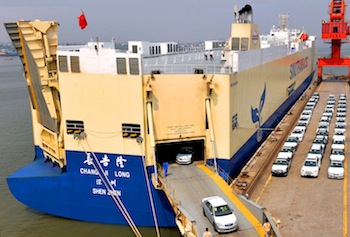
However, coastal shipping and barge transport have struggled to compete with road hauliers in China. There are a number of reasons for this that would be familiar in other markets, including road’s flexibility compared to water as well as its faster lead times. Last year, for example, sources said that Ford had moved some volume off of barge transport from its factories in Chongqing onto road to keep up with fast demand.
Cost, as everywhere else, is a major issue in China. However, while in many countries moving vehicles by water would be considerably cheaper than by road, in China this cost advantage is eroded by the widespread use of overloaded and extended car carriers, say experts. Although such loading is technically illegal, the government has been slow to establish an acceptable standard (although it is apparently close to doing so). In the meantime, ineffective enforcement has made such practices common, keeping road costs cheaper than many multimodal options.
Nevertheless, water transport does play a role in Chinese vehicle logistics, and a substantial one for some OEMs. The mode makes up around 7% of all new vehicle transport in China. However, Toyota and Shanghai General Motors make over 20% of their domestic car deliveries in China using water transport, according to Xin Jianmin of Shanghai Ansheng Automotive Shipping, who spoke at a CFLP seminar held in late 2013 on rail and ro-ro transport of vehicles. Shanghai Ansheng is a ro-ro shipping division of Anji Automotive Logistics (which is itself owned by Chinese carmaker SAIC), and an important ro-ro operator.
Other OEMs also use a high amount of barge transport, particularly those with factories along the Yangtze River, including Changan Ford in Chongqing, Dongfeng Peugeot Citroën Automobile (DPCA) and Dongfeng Honda in Wuhan, or Chery in Wuhu. However, Xin noted that while the absolute volume of vehicles moving by water has increased, the mode has not gained market share in China relative to road or, more recently, rail (which now has a similar share to water for vehicle logistics in China).
A small and saturated market
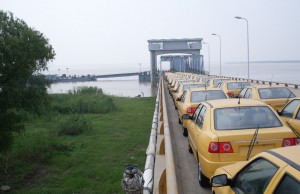
CSC Roro, a Shenzhen-based subsidiary of China’s largest logistics group Sinotrans-CSC, has the largest market share and base of clients for shipping, and is the only player that covers and connects China’s coast, river and international sea networks. According to Wang Peihai, deputy general manager of CSC Roro Logistics, the company was the first in China to engage in domestic vehicle ro-ro services, starting several decades ago when FAW-Volkswagen China needed to send its vehicles from Changchun in the north to main markets much further south at a time when the road and rail network were both insufficient for such transport.
Like many nations, including the US, China’s cabotage law restricts domestic water navigation to Chinese-flagged ships. However, it is more open than the railway sector, which largely operates vehicle transport through one, state-owned company. Foreign carriers get involved in this area by forming alliances with strong local players. Nykcos, for example, is a joint venture with China’s Cosco set up in as early as 2002, to serve the coasts. However, Cosco operates practically all of the domestic routes and fleets for the joint venture.
Local fleet upgrades
Along China’s east coast, ro-ro carriers generally run 2-3 trips per week. The Yangtze River sees a more frequent schedule of nearly one trip per day. At present, domestic ro-ro fleets dock mainly at the ro-ro ports of Haikou, Guangzhou, Shanghai, Yantai, Tianjin, Dalian, Wuhan and Chongqing. “Overall, the ro-ro operations are fairly efficient. Ships usually spend between several hours and a single day at a terminal,” says Wang. “Only Shanghai Haitong is more likely to get clogged during bad weather.”
Currently, there are more than 50 ro-ro vessels for services along the coast and the Yangtze River. Those vessels have an aggregate space for 45,800 vehicles and an annual transport capacity of roughly 2.5m units, according to Wang. Yangtze ro-ro fleets tend to have refurbished or newer ships, while coastal fleets have a higher share of older vessels.
There are signs that this balance will change, thanks in part to Chinese shipyards increasing ability to build or refurbish vessels. According to Wang, before 2009 most ro-ro vessels for coastal services in China were bought from overseas. “But now and in future, we are likely to build more and more new ro-ro vessels on our own [in China],” he says.
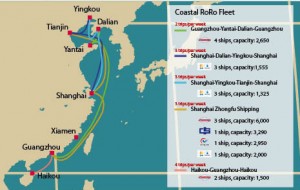 China's coastal shipping services
China's coastal shipping servicesMajor local carriers are now starting to address the ageing fleets on the coastal and short-sea shipping network, according to Xie Lie, chief operator officer and vice-president of NYK Automotive Logistics (China). By 2016, for example, CSC plans to add another two ro-ro vessels to its coastal fleet, each with 1,000-unit carrying space. It also plans to add two vessels to each its Yangtze River fleet and ocean fleet.
Lopsided capacity
In general, there does appear to be a shortage of shipping capacity for coastal ro-ro and short-sea shipping for China. However, the market suffers from severe imbalances. Logistics providers affiliated with OEMs – such as Shanghai Ansheng or Changhan Minsheng– almost automatically get that volume, and allocate their space for those customers. The growth of OEMs like SGM, SVW and Changan Ford has filled up available capacity quickly. On the other hand, independent or private shipping companies typically have spare capacity. CSC (which is not connected to an OEM but is partly state-owned through Sinotrans) built two ro-ro vessels in 2012 each with space for 2,000 units, but both are in layup for lack of demand.
The affiliated logistics providers tend to have an advantage when competing for third party business as well. As their parent OEMs' base volume allows them to make substantial investments, they can be competitive on many trade lanes. The lopsided capacity that this business model creates has also arguably prevented the overall sector from maturing its ro-ro services, with independent providers facing more uncertainty.
However, there is more opportunity for independent carriers that this model might suggest. As is the case in other logistics services in China, in-house providers often collaborate and subcontract capacity to independent carriers. On the Yangtze River, for example, Changan Minsheng subcontracts part of their assigned deliveries from Chongqing to CSC if they fit CSC’s shipping schedule. Likewise, Changan Minsheng may pick up some CSC loads from its base in Wuhan, where CSC moves cars for OEMs such as DPCA and Dongfeng Honda. Along the coast, Ansheng may get backloads from CSC after sailing south to dock at Guangzhou, and CSC from Ansheng after stopping at Shanghai.
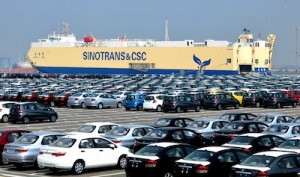 CSC has been expanding services to offer customers door-to-door transport, including last mile road delivery
CSC has been expanding services to offer customers door-to-door transport, including last mile road deliveryCSC, as the largest independent ro-ro carrier, has set up vehicle storage yards in Chongqing, Wuhan, Nangjing, Shanghai, Yantai, Dongguan and Haikou. Some ports saw strong growth in 2013, such as Dongguan where volumes exceeded 100,000 units. Vehicles are stored, transhipped and delivered by road to dealerships, and the provider is increasingly offering door-to-door services.
“Our road transport services offered at the moment are primarily short distance trucking intended to meet the needs associated with our ro-ro operations,” says Wang. “You can’t expect a client in the north, for instance, to arrange on their own to have cars delivered to dealerships after they arrive in Guangzhou. We do this for them.”
CSC Roro is interested in increasing the scale of its road business. But Wang admits that this would depend on when new standards and regulations are in place for car haulier trailers. As a company with a state-owned background, Wang says that CSC is less likely to risk breaking official rules. But the company is ultimately interested in getting involved in a more complete supply chain service.
“If we do start to expand our road capacity, it’s both for furthering our road link capability in operating ro-ro services, and for addressing the need for a total value chain that may be required by our clients,” he says.
Looking beyond China
CSC Roro is also involved in international ro-ro service as part of efforts to diversify its business. It is a strategy also linked to its mandates as a state-owned company to support an anticipated growth in exports out of China. “China’s cars are going to continue to keep leaving here for export,” says Wang. “We look to be there to give support somewhere.”
The company’s export services do not always involve its own vessels. A carmaker from Guangzhou, for example, may choose to export from Shanghai port. Cars would be transported to Shanghai on CSC ro-ro ships, from which point they may be shipped on either a CSC ship or another carrier, depending on the route. CSC has set up joint ventures with foreign carriers including Höegh Autoliners and MOL; it operates Southeast Asia routes with Höegh, for example.
Along the Yangtze River, CSC moves to Shanghai car exports bound for Southeast Asia for carmakers such as Changan, Lifan and Chery, and then goes on to sail to Yangon in Myanmar.
While several European, Japanese and Korean ro-ro giants take the lead in ro-ro services for China’s car exports, CSC Roro sees its domestic water and inland connections as an advantage, as well as its established freight forwarding business and close ties with carmakers. “In future when companies load a ro-ro vessel with storage space for 8,000 vehicles, they are sure to go on the domestic waterway routes after docking at a destination terminal in China,” Wang remarks. “Their strategies may well have to change in this direction.”
Rising rivers
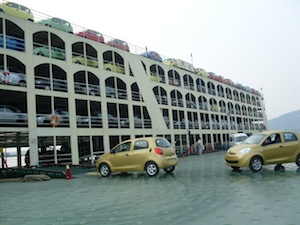
A number of logistics providers are planning to grow or add ro-ro fleets for coastal movements and the Yangtze River, including Shanghai Ansheng and Beijing Changjiu Logistics. Ansheng in particular is already expanding the shipping capacity of its ro-ro fleet on an impressive scale. A list of measures to promote multimodal practices have also been proposed, including constructing logistics hubs, increasing transhipping capability, and developing a highly effective IT system for multimodal transport.
However, at least until a new car haulier standard is in place, water’s share of vehicle transport will likely stay near its current levels, even as volume increases and performance improves. Carmakers will always choose transport based on a range of factors, including reliability and lead times. But at the end of the day, especially in China, cost tends to win most arguments. As road trucking becomes more regulated and operates in conformity with new standards, some experts have suggested that water could eventually make up as much as 15-20% of vehicle logistics. Of the major markets, only Japan and Europe could boast similar or higher levels of water transport.
For now, however, with the exception of some coastal or river-based OEMs, many carmakers still tend to use water transport only when they encounter difficulties on the road. It may still take some time before the mode really starts to sail in the right direction.

























![Global[1]](https://d3n5uof8vony13.cloudfront.net/Pictures/web/a/d/s/global1_726550.svgz)









